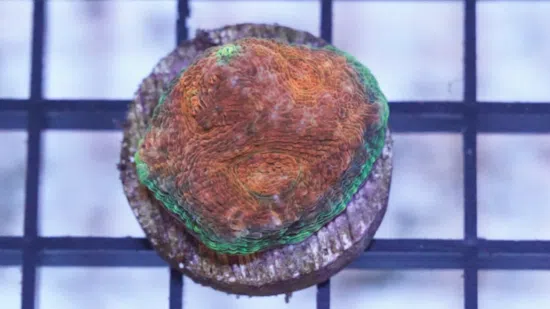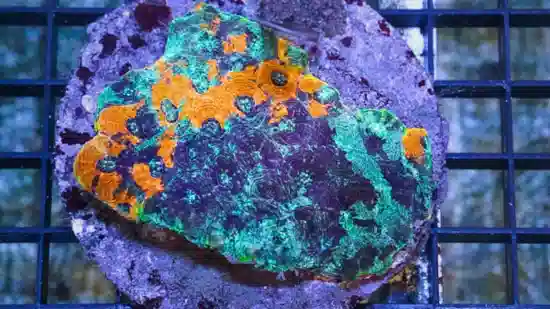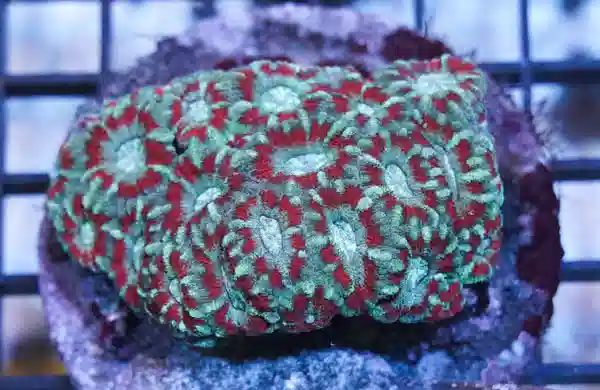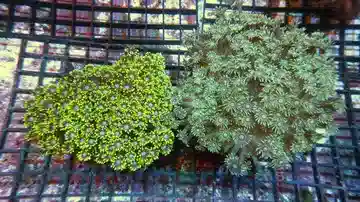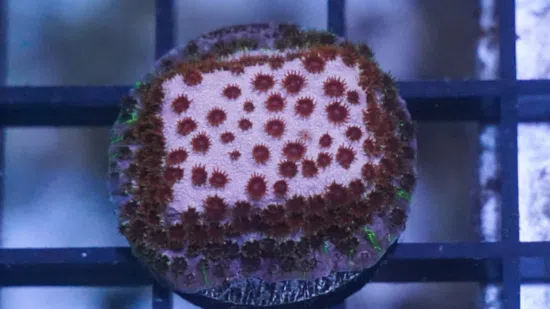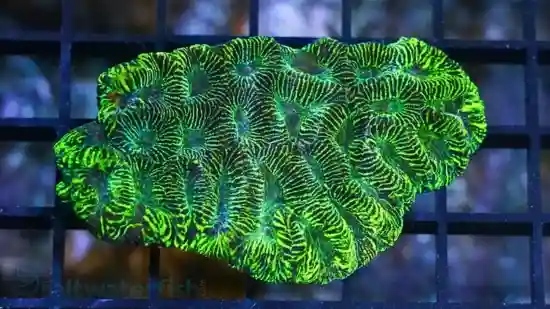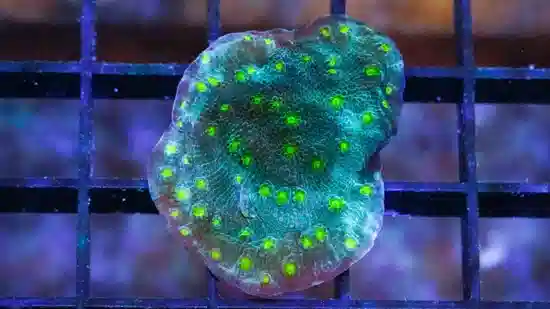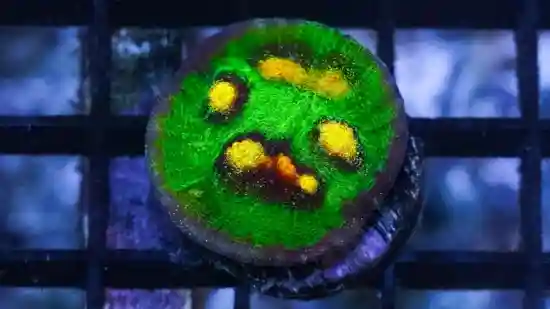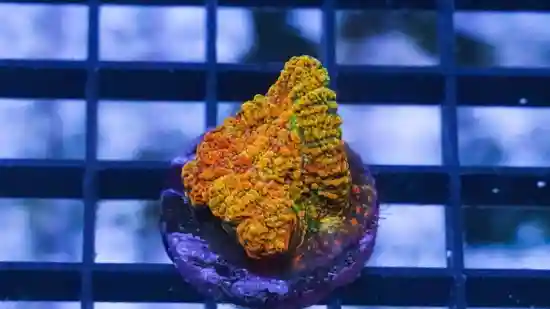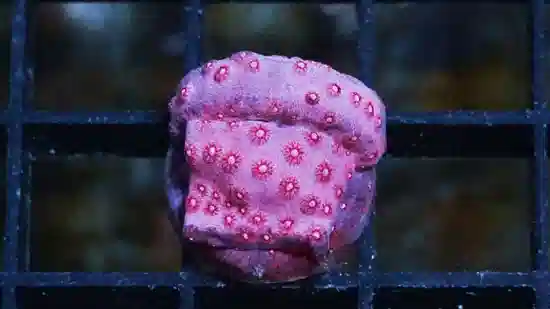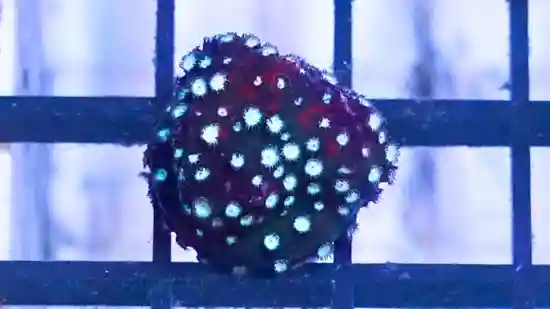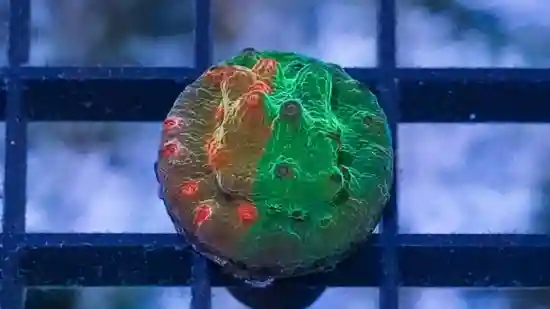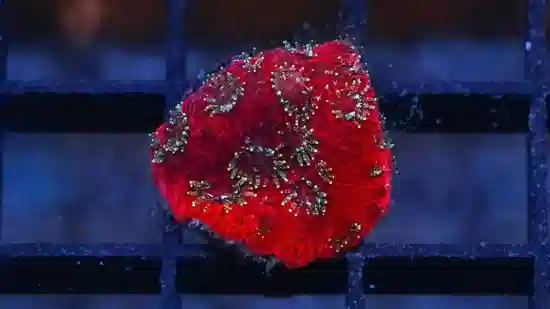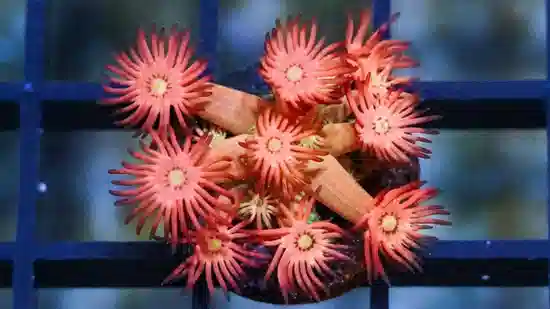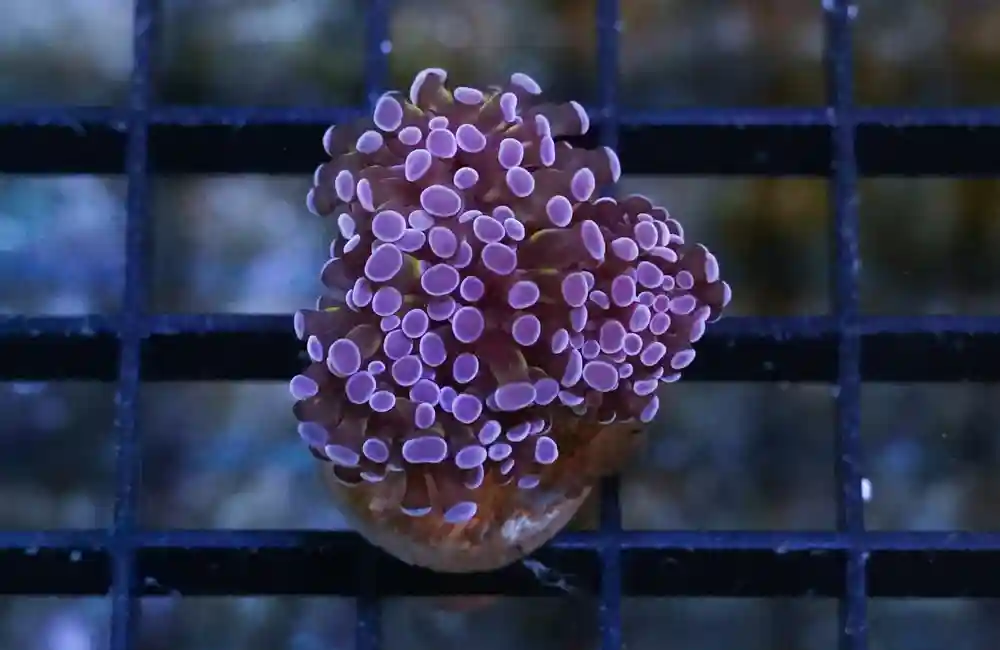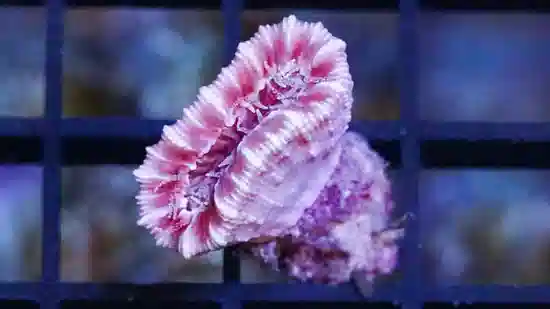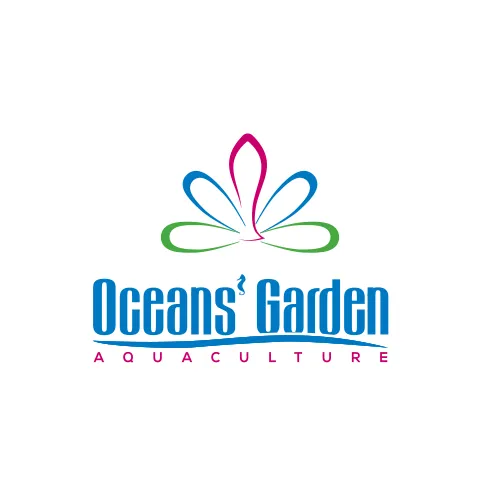LPS Corals In Saltwater Aquariums: FAQ
The terms LPS (Large Polyp Stony) corals and SPS (Small Polyp Stony) corals describe two major groups of stony corals commonly kept in saltwater aquariums. While both build hard calcium carbonate skeletons, they differ in appearance, care level, and tank requirements.
LPS Corals (Large Polyp Stony):
Appearance: Large, fleshy polyps with sweeping tentacles. Examples include Hammer, Torch, Frogspawn, and Brain corals.
Care level: Beginner to intermediate. LPS corals tolerate a wider range of conditions and grow more slowly.
Lighting & flow: Moderate lighting and gentle to moderate flow to keep polyps extended without damaging tissue.
Feeding: Readily benefit from direct feeding of meaty foods like mysis shrimp or coral pellets.
SPS Corals (Small Polyp Stony):
Appearance: Small, compact polyps covering branching or plating skeletons. Popular SPS include Acropora, Montipora, and Birdsnest corals.
Care level: Advanced. SPS require highly stable water parameters and pristine reef conditions.
Lighting & flow: Strong lighting (often high-output LEDs or metal halides) and strong, turbulent water flow.
Feeding: Primarily photosynthetic, but benefit from broadcast feeding of planktonic foods.
Key differences:
Polyp size: LPS have large, fleshy tentacles; SPS have tiny polyps.
Hardiness: LPS are more forgiving, while SPS demand precise stability in alkalinity, calcium, and magnesium.
Growth: LPS grow slowly with larger structures; SPS grow faster and form intricate branching colonies.
Faster-growing SPS corals, such as Acropora, exhibit higher calcification rates and are therefore more sensitive to changes in water chemistry, light, and temperature. In contrast, LPS corals with slower skeletal growth can better tolerate moderate nutrient and alkalinity variation. This difference in metabolic demand explains why SPS species require pristine stability in reef tanks (Anthony et al., 2008).
One Saltwaterfish.com reviewer of the Super Platygyra Brain Coral shared: “Love this Platygyra Brain Coral\! He is so beautiful and such an interesting personality\! He doesn't bother anyone and has actually become friends with our yellow wrasse\! They swim attached at the hip looking for food\! He is a very mellow swimmer who loves swimming through the rock work to find new caves. He is a little hard to feed when competing with quicker eaters, I let a couple pellets sink in front of him and sink a few spirulina flakes\! I highly recommend him, he is sweet, beautiful, and easy\!”*.
Bottom line: The difference between LPS and SPS corals comes down to polyp size, care requirements, and tank stability needs. LPS corals are ideal for beginners seeking color and movement, while SPS corals reward advanced reefers with fast growth and branching colonies. Both add beauty and structure to a reef, backed by Saltwaterfish.com’s healthy coral selection and 8-Day Live Guarantee.
LPS corals (Large Polyp Stony corals) thrive under moderate lighting conditions in reef aquariums. Unlike SPS corals, which demand very high-intensity light, most LPS prefer a balance that mimics their natural placement on reef slopes and lagoons, areas where light is strong but often filtered. Choosing the right lighting intensity helps your LPS corals expand fully, display vibrant colors, and maintain steady growth.
General lighting needs for LPS corals:
PAR range: 50–150 µmol/m²/s is ideal for most LPS species.
Light spectrum: Full-spectrum reef lighting (including blue, violet, and UV ranges) enhances fluorescence and supports photosynthesis through their symbiotic zooxanthellae.
Placement: Position LPS in the middle to lower regions of the tank, depending on species. Torch, Hammer, and Frogspawn corals often do best in moderate light, while Brain corals may prefer slightly lower intensity.
Lighting type: Modern LED fixtures are ideal, offering controllable intensity and spectrum. T5 and hybrid LED/T5 systems also perform well.
Why moderate lighting works best:
Too much light can cause bleaching or tissue retraction.
Too little light may stunt growth or dull coloration.
Many LPS extend their fleshy polyps more fully under gentle lighting and moderate flow.
Scientific research supports this moderate-light preference. Corals with larger polyps, such as most LPS species, host dense zooxanthellae populations and exhibit strong self-shading that reduces light stress. Studies show these corals achieve optimal photosynthesis and polyp expansion under mid-range light intensities, while excessive illumination leads to pigment loss and photoinhibition (Scheufen et al., 2017).
One Saltwaterfish.com reviewer of the Super Purple Goniopora Coral shared: “Perfect Goniopora Frag\! It’s healthy and opened immediately.”.
Pro tips for lighting LPS corals:
Acclimate corals to new lighting gradually using dimming features or screen acclimation.
Observe polyp extension, if corals retract or pale, adjust placement lower in the tank.
Pair moderate light with gentle to medium flow for best results.
Bottom line: LPS corals need moderate reef lighting (50–150 PAR) with a full spectrum to thrive. Place them in mid-to-lower areas of your tank and avoid sudden intensity changes. With stable light and water conditions, LPS corals like Torch, Hammer, and Brain corals will expand fully and show their best colors, backed by Saltwaterfish.com’s 8-Day Live Guarantee.
LPS (Large Polyp Stony) corals are hardy and adaptable, but to truly thrive they require stable reef water parameters that support both their fleshy polyps and their calcium-based skeletons. Unlike soft corals, LPS corals depend heavily on calcium and alkalinity for growth, so maintaining balance and stability is key.
Ideal water parameters for LPS corals:
Temperature: 74–78°F (23–26°C)
Salinity (Specific Gravity): 1.024–1.026
pH: 8.1–8.4
Alkalinity: 8–12 dKH (prevents tissue recession and promotes steady growth)
Calcium: 400–450 ppm (supports skeletal development)
Magnesium: 1250–1350 ppm (stabilizes calcium and alkalinity balance)
Nitrates: 2–10 ppm (LPS corals benefit from trace nutrients; zero nitrates can cause pale coloration)
Phosphates: 0.02–0.08 ppm (low but detectable levels support healthy zooxanthellae function)
Why these parameters matter:
Stable alkalinity, calcium, and magnesium are the foundation for strong skeleton growth.
Slightly higher nitrate and phosphate levels compared to SPS corals help LPS maintain color and polyp extension.
Consistency is more important than chasing “perfect” numbers. Rapid swings can stress LPS corals and cause tissue loss.
Coral calcification depends strongly on balanced and stable carbonate chemistry, specifically alkalinity, calcium, and magnesium. Research by Langdon & Atkinson (2005) found that fluctuations in these ions significantly reduce calcification efficiency, even under otherwise favorable conditions.
One Saltwaterfish.com reviewer of the Solitary Cup Coral \- Australia shared: “Perfect for my smaller rock areas, very nice color”.
Pro tips for LPS coral care:
Test alkalinity, calcium, and magnesium weekly. Dose supplements if levels drop.
Perform regular water changes to replenish trace elements.
Don’t strip the water of all nutrients. LPS often fade in “ultra-low nutrient” systems.
- Observe polyp extension daily, shrunken polyps often indicate water instability.
Bottom line: To thrive, LPS corals need stable reef parameters: Ca 400–450 ppm, Alk 8–12 dKH, Mg 1250–1350 ppm, nitrates 2–10 ppm, and phosphates 0.02–0.08 ppm. Keep conditions consistent and avoid drastic swings, and your LPS corals will reward you with full polyp extension, vibrant color, and steady growth, backed by Saltwaterfish.com’s 8-Day Live Guarantee.
In the reef aquarium hobby, LPS stands for “Large Polyp Stony” corals. This group of corals is defined by their large, fleshy polyps and hard calcium carbonate skeletons. The term “LPS” is used to distinguish them from SPS (Small Polyp Stony) corals, which have much smaller polyps and higher care demands.
Key characteristics of LPS corals:
Large polyps: Each polyp is fleshy and often brightly colored, giving LPS corals a dramatic, flowing appearance. Examples include Hammer, Torch, Frogspawn, Acan, and Brain corals.
Stony skeleton: Like SPS, LPS corals build rigid skeletons that contribute to reef structure, but their polyp size makes them appear softer and more dynamic.
Moderate care level: LPS are generally more forgiving than SPS corals, making them suitable for beginner and intermediate reef keepers.
Feeding: Many LPS corals benefit from direct feeding with mysis shrimp, brine shrimp, or specialized coral foods in addition to photosynthesis.
Lighting & flow: They thrive under moderate lighting and gentle to medium water flow, which keeps their fleshy polyps extended without damaging tissue.
Why the distinction matters:
LPS vs. SPS: Understanding the difference helps aquarists choose corals that match their tank conditions and experience level.
Tank compatibility: LPS corals often have long, stinging sweeper tentacles, so placement is important to avoid damaging nearby corals.
One Saltwaterfish.com reviewer of the Long Tentacle Plate Coral shared: “Received my plate coral and it was in great condition\! It started opening in the tank almost immediately and to my surprise even it's tentacles are bright green\! It is almost 5" diameter and looks fantastic under my LED lights\! Beautiful coral\! Thanks\!”*.
Bottom line: LPS stands for “Large Polyp Stony” corals, a group of stony corals with fleshy, colorful polyps and hard skeletons. They are beginner-friendly, thrive under moderate light and flow, and bring vibrant movement and structure to reef tanks, backed by Saltwaterfish.com’s 8-Day Live Guarantee.
LPS (Large Polyp Stony) corals are some of the most rewarding additions to a reef aquarium, combining vibrant colors, fleshy polyps, and flowing movement. They are more forgiving than SPS corals, but they still require stable conditions and attentive care to thrive. By providing the right lighting, flow, feeding, and water chemistry, you can enjoy healthy, growing colonies for years.
Core care requirements for LPS corals:
Lighting: Moderate intensity (50–150 PAR) with a full reef spectrum. Place them mid-to-low in the tank where light is strong but not overwhelming.
Flow: Gentle to moderate, enough to keep polyps swaying but not tearing. Direct blasts can damage their fleshy tissue.
Water parameters:
Temp: 74–78°F
Salinity: 1.024–1.026
pH: 8.1–8.4
Alkalinity: 8–12 dKH
Calcium: 400–450 ppm
Magnesium: 1250–1350 ppm
Nitrates: 2–10 ppm
Phosphates: 0.02–0.08 ppm
Feeding: Many LPS corals benefit from target feeding 1–2 times per week with mysis shrimp, brine shrimp, reef roids, or coral pellets. Feeding enhances polyp expansion, growth, and coloration.
Placement: Allow space between LPS and other corals. Some (like Torch and Hammer corals) extend long sweeper tentacles that can sting neighbors.
Why care consistency matters:
LPS corals are hardy but sensitive to rapid swings in alkalinity, calcium, or salinity. Stability is often more important than chasing “perfect” numbers.
One Saltwaterfish.com reviewer of the Red w/ Green Lobophyllia Brain Coral shared: “Doing great. Very nice coral.”.
Pro tips for LPS care:
Acclimate new corals slowly to lighting changes.
Watch polyp extension. Retracted tissue may indicate too much flow, light, or unstable parameters.
Perform regular water changes to replenish trace elements.
- Keep a secure lid, fish that perch or pick at corals can stress them.
Bottom line: To care for LPS corals, provide moderate light, moderate flow, stable water parameters, and supplemental feeding. With these conditions, LPS corals like Torch, Hammer, and Candy Cane will thrive, adding movement and color to your reef, backed by Saltwaterfish.com’s 8-Day Live Guarantee.
LPS (Large Polyp Stony) corals are among the most popular choices for beginner to intermediate reef keepers because they combine vibrant colors, flowing polyps, and relative hardiness compared to SPS corals. They thrive under moderate lighting, moderate flow, and stable, but not ultra-demanding, water parameters, making them a forgiving and rewarding coral group.
Best beginner to intermediate LPS corals:
Hammer Coral (Euphyllia ancora) – A reef favorite with hammer-shaped tips that sway beautifully in the current. Hardy and fast-growing under moderate light and flow.
*Torch Coral (Euphyllia glabrescens) – Known for long, waving tentacles and neon coloration. Slightly more aggressive than Hammers and Frogspawns, so give them space.
*Frogspawn Coral (Euphyllia divisa) – Peaceful, hardy, and forgiving, with plump polyps that resemble frog eggs. Excellent for beginners.
*Candy Cane / Trumpet Coral (Caulastrea furcata) – Easy to care for, with round polyps and bright green or blue coloration. Grows steadily and tolerates a range of conditions.
*Acan Lord Coral (Micromussa lordhowensis) – Compact, colorful colonies with high feeding response. Perfect for nano reefs or shaded areas of larger tanks.
*Brain Corals (e.g., Favites or Platygyra) – Hardy, tolerant of moderate light, and a stunning centerpiece for larger aquariums.
Why these corals are ideal:
They tolerate a wider nutrient range than SPS corals.
Most grow steadily without needing constant dosing, though calcium and alkalinity monitoring is still important.
They benefit from occasional target feeding of mysis shrimp, reef roids, or pellets, making them visually interactive.
One Saltwaterfish.com reviewer of the Cyphastrea Copperhead shared: “Nice frag, coral had plated all the way to the plug itself.”.
Pro tips for success:
Place LPS corals in moderate light and flow zones; too much can damage their fleshy polyps.
Allow space around Torch and Hammer corals, as their sweeper tentacles can sting neighbors.
- Feed 1–2 times weekly to boost growth and color.
Bottom line: The best LPS corals for beginner to intermediate reef tanks include Hammer, Torch, Frogspawn, Candy Cane, Acan, and Brain corals. These species combine beauty, movement, and hardiness, making them perfect for reefers who want corals that are forgiving yet visually stunning, backed by Saltwaterfish.com’s 8-Day Live Guarantee.
LPS (Large Polyp Stony) corals are reef safe and thrive in mixed aquariums with the right companions. Choosing suitable tank mates is essential, since LPS corals have fleshy polyps that can be damaged by aggressive fish or invertebrates. The best companions are peaceful reef fish, gentle invertebrates, and compatible corals that won’t compete for space.
Best fish tank mates for LPS corals:
Clownfish (Amphiprion spp.) – Peaceful and reef safe; often host nearby but do not harm LPS corals.
Gobies (e.g., Watchman or Neon Gobies) – Small, bottom-dwelling fish that help clean and aerate sand without disturbing corals.
Blennies (e.g., Tailspot or Lawnmower Blenny) – Great algae controllers and generally peaceful around corals.
Cardinalfish (Banggai, Pajama, Longspine) – Calm, schooling fish that add mid-water movement without aggression.
Reef-safe wrasses (e.g., Fairy, Flasher, Melanurus) – Active and colorful but not coral nippers.
Best invertebrate tank mates for LPS corals:
Cleaner shrimp (e.g., Skunk Cleaner, Peppermint Shrimp) – Assist with detritus cleanup and won’t bother LPS.
Snails (Turbo, Trochus, Nassarius) – Essential algae grazers that safely navigate around corals.
Hermit crabs (reef-safe varieties) – Help manage algae and detritus, though they should have spare shells to avoid aggression.
Coral compatibility:
Other LPS corals (Candy Cane, Acan, Trumpet) can coexist if placed with proper spacing.
Soft corals (Zoanthids, Mushrooms, Leathers) often mix well with LPS.
Avoid placing LPS too close to aggressive SPS or other Euphyllia species with long sweeper tentacles unless spacing is generous.
One Saltwaterfish.com reviewer of the Color Symphyllia Brain Coral shared: “Got my order this weekend and was blowed away. They were everything they said they would be.Very happy customer.Cant wait to get some more.Thank you guys so much\!”.
Pro tips for LPS compatibility:
Leave at least 3–5 inches of space around Torch, Hammer, and Frogspawn corals to avoid stings.
Choose peaceful reef fish over aggressive species like large angelfish, triggers, or puffers.
Maintain a balanced cleanup crew to reduce algae growth around coral bases.
Bottom line: The best tank mates for LPS corals include peaceful reef fish (clownfish, gobies, cardinals), reef-safe invertebrates (shrimp, snails, hermits), and compatible soft or stony corals. With proper spacing and peaceful companions, your LPS corals will expand fully, display vibrant colors, and thrive, backed by Saltwaterfish.com’s 8-Day Live Guarantee.
LPS (Large Polyp Stony) corals contain symbiotic zooxanthellae that provide energy through photosynthesis, but to thrive, they also benefit from supplemental feeding. Feeding your LPS corals properly helps improve growth rates, polyp expansion, and vibrant coloration. Many aquarists notice faster skeletal growth and fuller polyp inflation when feeding is part of their routine.
Best foods for LPS corals:
Meaty frozen foods: Mysis shrimp, brine shrimp, finely chopped seafood.
Coral pellets/powders: Specialized foods like Reef Roids, Coral Frenzy, or high-quality coral pellets.
Phytoplankton and zooplankton: Beneficial for smaller-polyp LPS and for improving overall tank biodiversity.
Feeding method:
Turn off pumps/flow – This prevents food from blowing away.
Target feed with a pipette or turkey baster – Place food gently on coral mouths/tentacles (common in Torch, Hammer, Frogspawn, Acan, and Candy Cane corals).
Allow 5–15 minutes for capture – Polyps extend and pull food into their mouths when healthy.
Restart flow – Helps clear excess food and maintain oxygenation.
How often to feed LPS corals:
1–2 times per week is enough for most tanks.
More frequent feedings can accelerate growth but may increase nutrients, balance with regular water changes or filtration.
Why feeding matters:
Encourages faster growth and fragging potential.
Boosts immune response and recovery from stress.
Enhances fluorescent colors, especially under blue reef lighting.
One Saltwaterfish.com reviewer of the Pink/Purple Tip Elegance Coral shared: “Very beautiful and have three in my tanks now and want more.”.
Pro tips for feeding LPS corals:
Spot feed at night or early morning when polyps are more extended.
Don’t overfeed. Excess food can spike nutrients and fuel algae.
- Rotate foods to provide balanced nutrition.
Bottom line: To feed LPS corals, target feed meaty foods or coral-specific diets 1–2 times per week, with pumps off and direct delivery to polyps. Consistent supplemental feeding promotes vibrant color, steady growth, and long-term health, backed by Saltwaterfish.com’s 8-Day Live Guarantee.
LPS (Large Polyp Stony) corals are prized for their fleshy polyps and vibrant colors. A healthy LPS coral will display consistent polyp extension, strong coloration, and steady growth, while stress signs include tissue recession or retraction. Learning to recognize these cues helps you act quickly to correct issues and keep your corals thriving.
Signs of a healthy LPS coral:
Polyp extension: Tentacles or fleshy tissue expand fully during the day, swaying gently in the current.
Vibrant coloration: Bright, consistent colors without fading, bleaching, or dark spots.
Active feeding response: When target-fed with mysis or coral food, healthy corals quickly grab and ingest food.
Steady skeletal growth: New ridges or budding polyps appear around colony edges.
Firm tissue: Fleshy polyps look full, not shriveled or receding from the skeleton.
Signs of stress or decline:
Tissue recession exposing white skeleton.
Closed or retracted polyps for extended periods.
Bleaching or loss of color (from too much light or unstable parameters).
Brown jelly infection or tissue sloughing (requires immediate attention).
One Saltwaterfish.com reviewer of the Green Torch Coral shared: “These are absolutely beautiful\!\!\! If I could, I’d put 20 of these in my tanks. If you don’t already have one or more, then hurry up and purchase a few right here on saltwater fish.com.”.
Pro tips for monitoring LPS health:
Check polyp extension daily, shrunken tissue is often the first stress signal.
Track growth over months; slow but steady expansion is normal.
Quarantine new corals to prevent pests or infections.
Bottom line: A healthy LPS coral shows full polyp extension, bright coloration, feeding response, and steady growth. By maintaining stable reef parameters and watching for changes in tissue or color, you’ll ensure your corals stay vibrant and long-lived, backed by Saltwaterfish.com’s 8-Day Live Guarantee.
When comparing coral care levels, LPS (Large Polyp Stony) corals are considered intermediate in difficulty, generally easier to keep than SPS corals but requiring more attention than most soft corals. They strike a balance, making them ideal for reef keepers who are ready to go beyond beginner corals but not yet prepared for the strict demands of SPS species.
Soft corals (easiest):
Examples: Zoanthids, Mushrooms, Leather corals.
Very hardy and tolerant of a wide range of water conditions.
Do not require dosing of calcium or alkalinity for skeletal growth.
Excellent for beginners starting their first reef tank.
LPS corals (moderate difficulty):
Examples: Hammer, Torch, Frogspawn, Candy Cane, Acan corals.
Require stable water chemistry for skeletal development (Ca 400–450 ppm, Alk 8–12 dKH, Mg 1250–1350 ppm).
Thrive under moderate lighting and moderate flow.
Benefit from supplemental feeding of meaty foods 1–2 times per week.
More forgiving than SPS but more sensitive than soft corals to swings in parameters.
SPS corals (most advanced):
Examples: Acropora, Montipora, Birdsnest corals.
Demand very high light (200–350 PAR+), strong turbulent flow, and ultra-stable water chemistry.
Sensitive to nutrient swings, often requiring automated dosing and advanced filtration.
Best suited for experienced aquarists.
Gattuso et al. (1999) showed that corals with rapid skeletal growth, such as Acropora (SPS), are far more sensitive to fluctuations in alkalinity and carbonate chemistry. In contrast, LPS species have slower calcification rates and higher feeding capacity, allowing them to tolerate moderate nutrients and less pristine conditions (Houlbrèque & Ferrier-Pagès, 2009). This balance makes LPS corals the ideal “bridge” group between beginner-friendly soft corals and the more demanding SPS varieties.
One Saltwaterfish.com reviewer of the Green Tip Torch Coral shared: “Great Torch Coral\! Came in with 4 heads and is much larger than expected\! Actually started coming out while acclimating it in the bag\! Looks awesome in my 250G aquarium under the LED lights\! Very pleased\!”.
Pro tips for choosing coral difficulty:
Start with soft corals if you’re new to reefing.
Move to LPS once you’re comfortable maintaining stable water chemistry.
Graduate to SPS only when you can provide high light, strong flow, and precise dosing.
Bottom line: LPS corals are not as easy as soft corals but far more forgiving than SPS corals. They’re the perfect step-up for reefers looking to enjoy stunning color, movement, and growth without the extreme demands of high-end SPS tanks, backed by Saltwaterfish.com’s 8-Day Live Guarantee.

